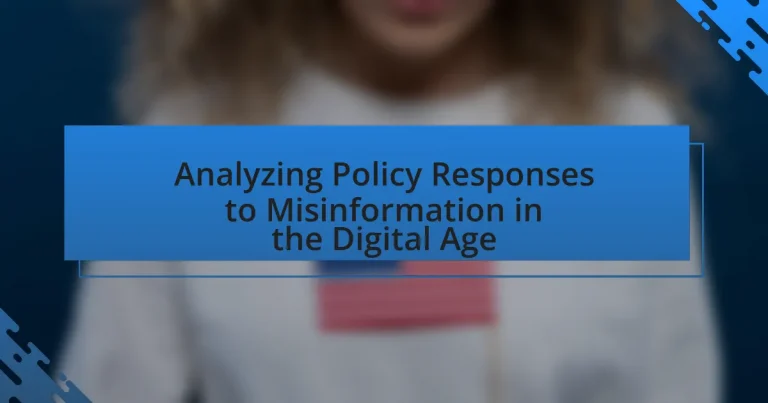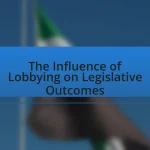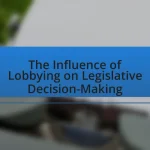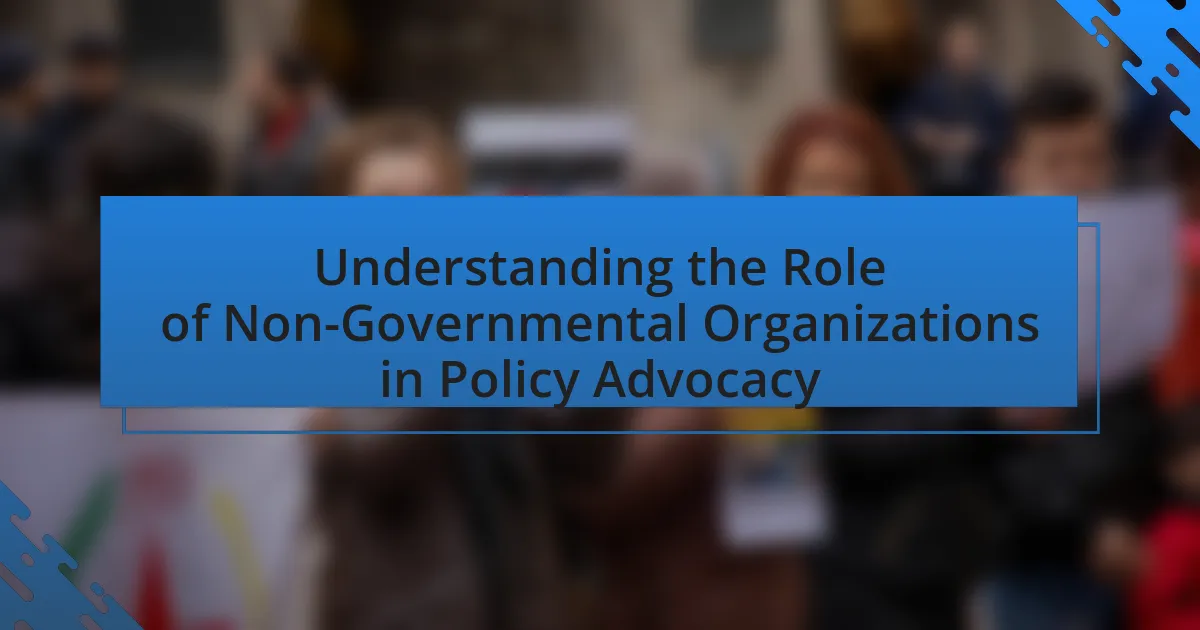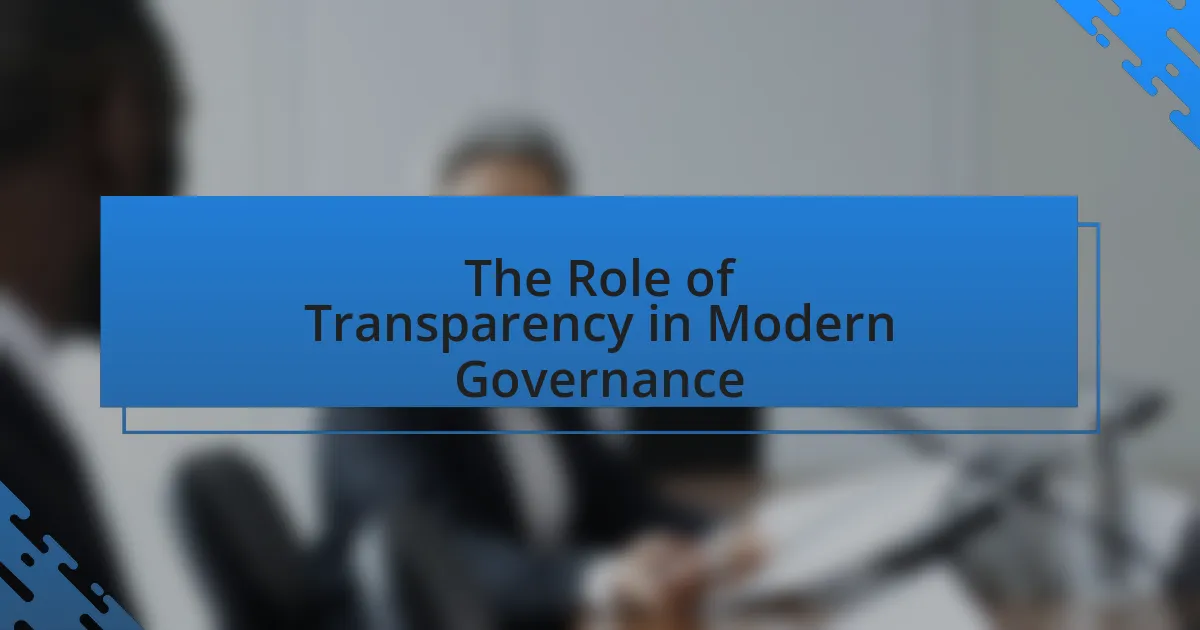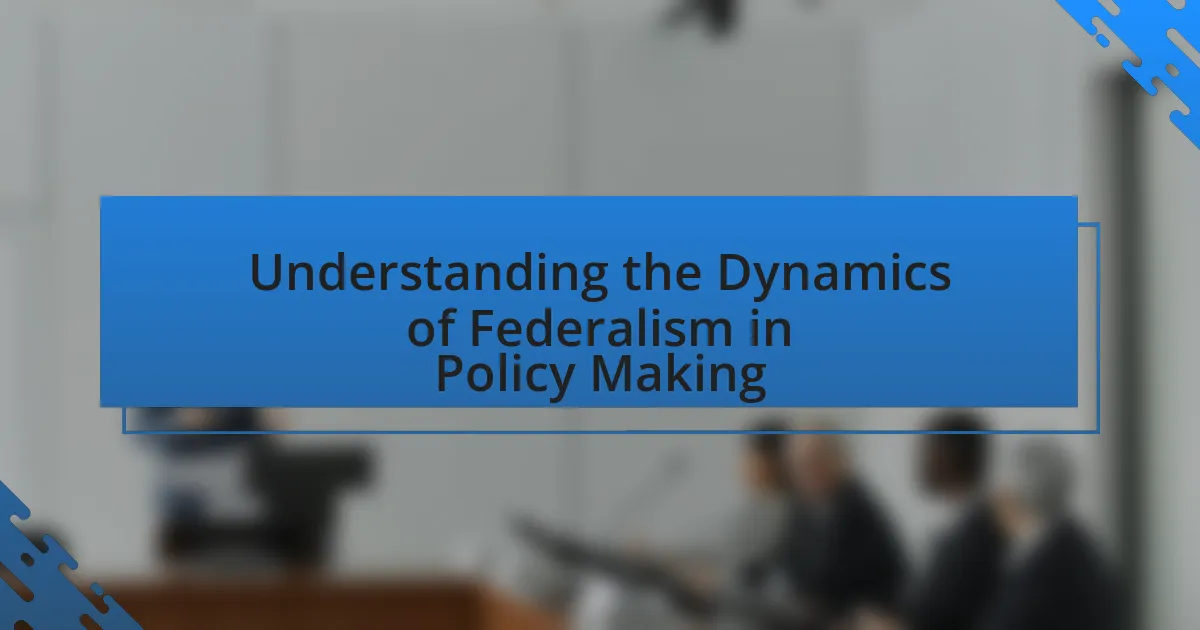The article focuses on analyzing policy responses to misinformation in the digital age, highlighting the key challenges posed by the rapid spread of false information, difficulties in identifying credible sources, and the erosion of public trust in institutions. It examines how misinformation proliferates through social media platforms, driven by algorithms that prioritize engagement over accuracy, and discusses the societal impacts, including increased polarization and public health risks. The article also reviews various policy measures implemented to combat misinformation, such as content moderation regulations and educational initiatives, while evaluating their effectiveness and proposing future directions for enhancing policy responses.
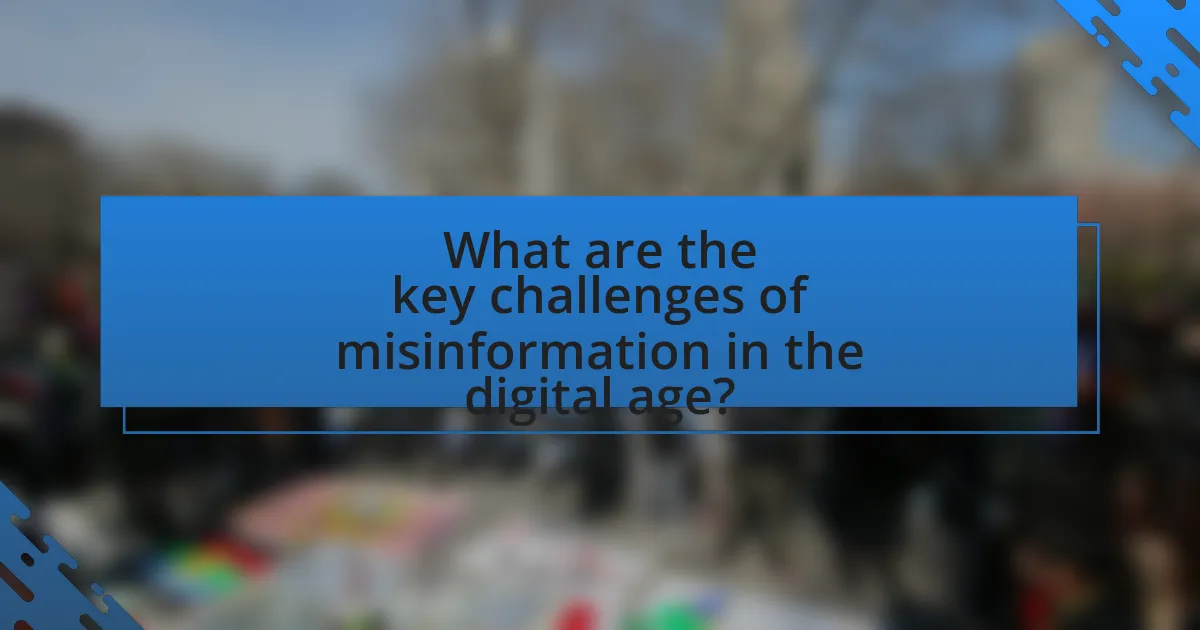
What are the key challenges of misinformation in the digital age?
The key challenges of misinformation in the digital age include the rapid spread of false information, the difficulty in identifying credible sources, and the impact on public trust. The internet and social media platforms enable misinformation to circulate quickly, often outpacing fact-checking efforts. Research indicates that false information is 70% more likely to be retweeted than true information, highlighting the challenge of combating its spread. Additionally, users often struggle to discern reliable sources, as algorithms prioritize engagement over accuracy, leading to echo chambers and confirmation bias. This environment erodes public trust in media and institutions, complicating efforts to address misinformation effectively.
How does misinformation spread in digital environments?
Misinformation spreads in digital environments primarily through social media platforms, where users share content rapidly without verifying its accuracy. The algorithms of these platforms often prioritize engagement over factual correctness, leading to the viral dissemination of misleading information. A study by Vosoughi, Roy, and Aral in 2018 found that false news stories are 70% more likely to be retweeted than true stories, highlighting the significant role of user behavior and platform design in the spread of misinformation. Additionally, echo chambers and filter bubbles reinforce existing beliefs, making users more susceptible to accepting and sharing false information.
What role do social media platforms play in the dissemination of misinformation?
Social media platforms significantly contribute to the dissemination of misinformation by enabling rapid sharing and amplifying false narratives. Their algorithms prioritize engagement, often promoting sensational content over factual accuracy, which can lead to widespread misinformation reaching large audiences quickly. For instance, a study published in the journal Science found that false news stories spread more rapidly on Twitter than true stories, with false information being 70% more likely to be retweeted. This highlights the role of social media in not only facilitating the spread of misinformation but also in shaping public perception and discourse.
How do algorithms contribute to the spread of false information?
Algorithms contribute to the spread of false information by prioritizing engagement over accuracy, leading to the amplification of sensational or misleading content. Social media platforms utilize algorithms that favor posts with high interaction rates, such as likes, shares, and comments, regardless of their factual correctness. Research by the Massachusetts Institute of Technology found that false news spreads significantly faster and reaches more people than true news on Twitter, primarily due to algorithmic biases that promote emotionally charged content. This mechanism creates an environment where misinformation can thrive, as users are more likely to engage with provocative headlines, further perpetuating the cycle of false information dissemination.
Why is it important to address misinformation?
Addressing misinformation is crucial because it undermines public trust, distorts reality, and can lead to harmful consequences. Misinformation can influence public opinion, affect democratic processes, and contribute to societal division. For instance, a study by the Pew Research Center found that 64% of Americans believe that misinformation has a significant impact on their ability to make informed decisions. By addressing misinformation, societies can promote informed decision-making, enhance public discourse, and safeguard democratic institutions.
What are the societal impacts of misinformation?
Misinformation has significant societal impacts, including the erosion of public trust in institutions, increased polarization, and detrimental effects on public health. The spread of false information undermines confidence in government, media, and scientific communities, leading to skepticism and disengagement from civic processes. For instance, a study by the Pew Research Center found that 64% of Americans believe that misinformation has a major impact on their trust in news sources. Additionally, misinformation contributes to societal polarization by reinforcing existing biases and creating echo chambers, where individuals are exposed only to information that aligns with their beliefs. This division can hinder constructive dialogue and compromise. In the realm of public health, misinformation about vaccines has led to decreased vaccination rates, resulting in outbreaks of preventable diseases, as evidenced by the resurgence of measles in areas with low vaccination coverage. These impacts illustrate the profound consequences of misinformation on societal cohesion and public well-being.
How does misinformation affect public trust in institutions?
Misinformation significantly undermines public trust in institutions by creating doubt about their credibility and intentions. When individuals encounter false information, they often question the reliability of the sources, leading to a general skepticism towards institutions such as government, media, and healthcare. Research conducted by the Pew Research Center in 2020 found that 53% of Americans believe that misinformation has caused them to lose trust in the government. This erosion of trust can result in decreased public compliance with institutional guidelines, as seen during the COVID-19 pandemic, where misinformation about vaccines led to lower vaccination rates and public health challenges.
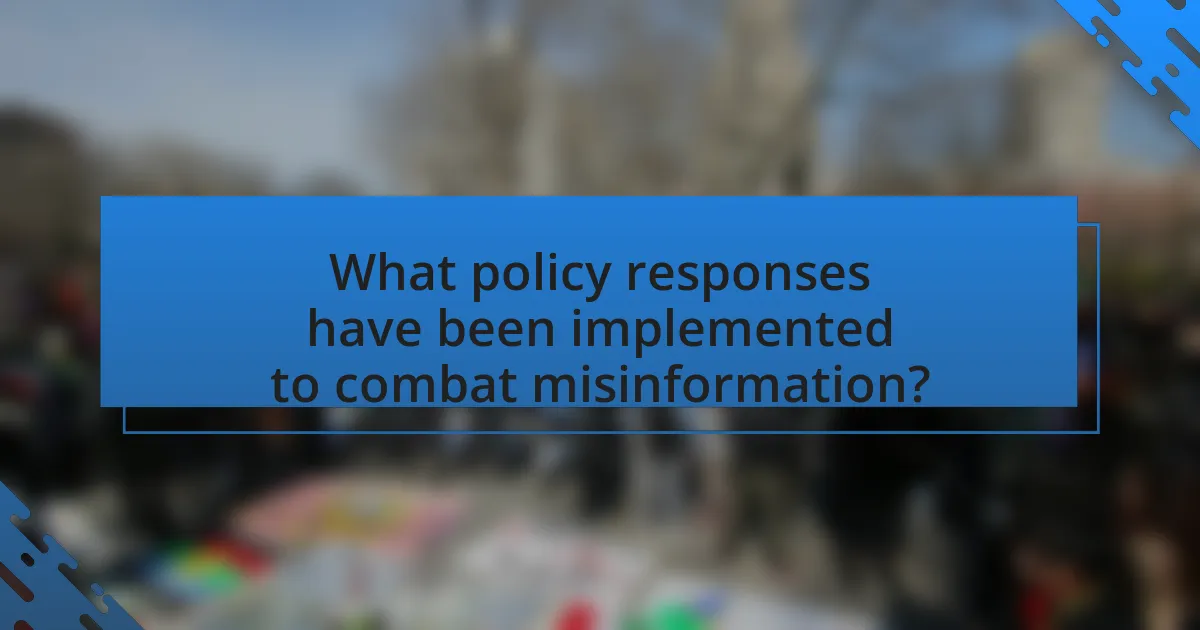
What policy responses have been implemented to combat misinformation?
Governments and organizations have implemented various policy responses to combat misinformation, including legislation, fact-checking initiatives, and partnerships with technology platforms. For instance, the European Union’s Digital Services Act mandates that online platforms take responsibility for content moderation and transparency in advertising, aiming to reduce the spread of false information. Additionally, countries like the United States have seen the establishment of fact-checking organizations, such as the Poynter Institute’s PolitiFact, which work to verify claims made in public discourse. These measures are supported by research indicating that structured interventions can significantly decrease the prevalence of misinformation online.
What types of policies are being proposed or enacted?
Various policies are being proposed or enacted to combat misinformation in the digital age, including content moderation regulations, transparency requirements for social media platforms, and educational initiatives aimed at improving media literacy. Content moderation regulations often mandate platforms to remove false information promptly, while transparency requirements may involve disclosing algorithms that prioritize content. Educational initiatives focus on equipping individuals with critical thinking skills to discern credible information sources. These approaches are supported by research indicating that misinformation can significantly influence public opinion and behavior, necessitating effective policy responses.
How do content moderation policies differ across platforms?
Content moderation policies differ across platforms primarily in their enforcement mechanisms, definitions of harmful content, and user engagement strategies. For instance, Facebook employs a combination of automated systems and human reviewers to identify and remove content that violates its community standards, which include hate speech and misinformation. In contrast, Twitter focuses on labeling tweets that may contain misleading information rather than outright removal, allowing for user context and discussion. YouTube utilizes a three-tiered approach that includes automated content detection, user reporting, and human review, particularly for videos that may violate its policies on hate speech and misinformation. These differences reflect each platform’s unique approach to balancing free expression with the need to mitigate harmful content, as evidenced by their varying transparency reports and community guidelines.
What legal frameworks are being considered to regulate misinformation?
Legal frameworks being considered to regulate misinformation include the Digital Services Act (DSA) in the European Union and various state-level laws in the United States, such as California’s AB 5. The DSA aims to hold online platforms accountable for harmful content, requiring them to take proactive measures against misinformation. California’s AB 5 focuses on transparency in political advertising and mandates disclosure of funding sources for misinformation campaigns. These frameworks are designed to enhance accountability and promote accurate information dissemination in the digital landscape.
How effective are current policy responses?
Current policy responses to misinformation in the digital age are moderately effective but face significant challenges. For instance, regulations like the European Union’s Digital Services Act aim to hold platforms accountable for harmful content, yet enforcement remains inconsistent across member states. Studies indicate that while these policies can reduce the spread of misinformation, their impact is often limited by the rapid evolution of digital platforms and the tactics employed by misinformation spreaders. Furthermore, a report by the Pew Research Center highlights that public trust in these policies is low, which undermines their overall effectiveness.
What metrics are used to evaluate the success of these policies?
Metrics used to evaluate the success of policies addressing misinformation in the digital age include engagement rates, misinformation spread reduction, user trust levels, and fact-checking accuracy. Engagement rates measure how effectively the policy encourages users to interact with credible information sources. Misinformation spread reduction quantifies the decrease in the dissemination of false information across platforms, often assessed through tracking shares and views of misleading content. User trust levels gauge public confidence in information sources, typically measured through surveys. Fact-checking accuracy evaluates the effectiveness of verification processes, often reflected in the percentage of claims accurately identified as true or false. These metrics provide a comprehensive framework for assessing the impact of policies aimed at combating misinformation.
What case studies illustrate successful policy interventions?
Case studies illustrating successful policy interventions in combating misinformation include the European Union’s Code of Practice on Disinformation and the United Kingdom’s Online Safety Bill. The European Union’s initiative, established in 2018, brought together major tech companies to commit to transparency and accountability measures, resulting in a reported 80% reduction in the visibility of disinformation during the 2019 European Parliament elections. The UK’s Online Safety Bill, introduced in 2021, aims to regulate harmful online content, with provisions that hold platforms accountable for misinformation, thereby enhancing user safety and trust. These examples demonstrate effective policy frameworks that have led to measurable improvements in managing misinformation in digital spaces.
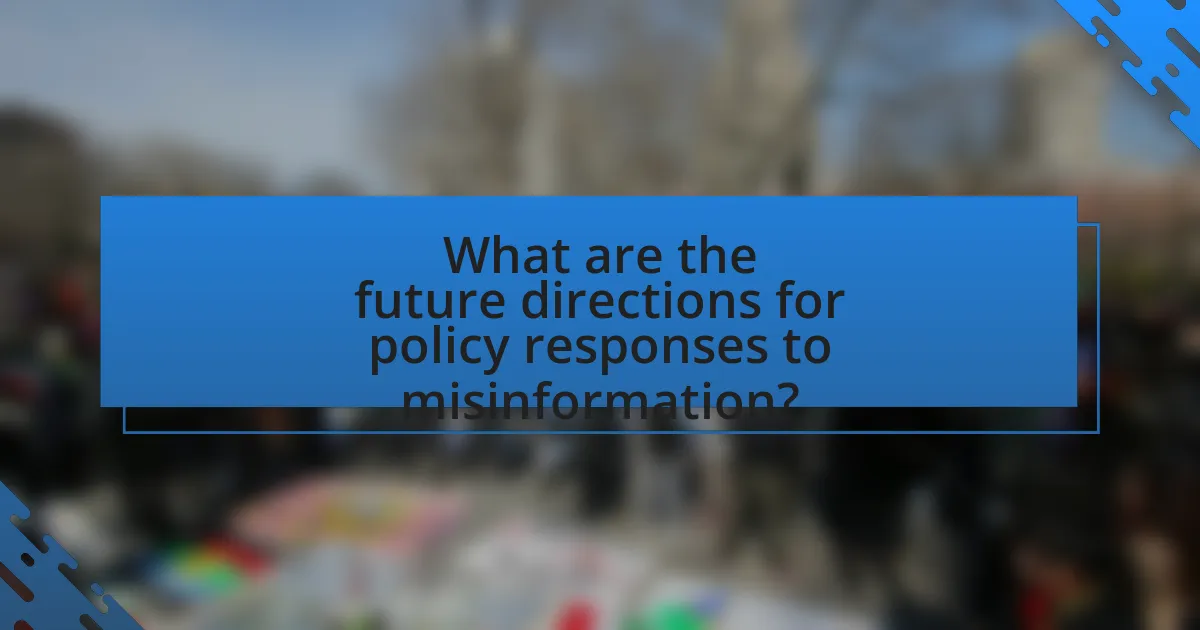
What are the future directions for policy responses to misinformation?
Future directions for policy responses to misinformation include the implementation of stricter regulations on social media platforms, enhanced collaboration between governments and tech companies, and the promotion of digital literacy among the public. Stricter regulations may involve requiring platforms to take more responsibility for the content shared on their sites, as evidenced by the European Union’s Digital Services Act, which mandates transparency in content moderation. Collaboration can lead to the development of shared frameworks for identifying and combating misinformation, as seen in initiatives like the Global Partnership for Artificial Intelligence. Additionally, promoting digital literacy is crucial, as studies show that informed users are better equipped to discern credible information from falsehoods, thereby reducing the spread of misinformation.
How can technology be leveraged to improve policy effectiveness?
Technology can be leveraged to improve policy effectiveness by utilizing data analytics and machine learning to inform decision-making processes. For instance, governments can analyze large datasets from social media and online platforms to identify misinformation trends and public sentiment, enabling them to craft targeted interventions. A study by the Pew Research Center found that 64% of Americans believe that social media has a significant impact on the spread of misinformation, highlighting the need for data-driven policy responses. By employing real-time monitoring tools, policymakers can adapt strategies quickly based on emerging data, thereby enhancing the responsiveness and relevance of their policies in combating misinformation.
What role do artificial intelligence and machine learning play in combating misinformation?
Artificial intelligence and machine learning play a crucial role in combating misinformation by enabling the automated detection, analysis, and classification of false information across digital platforms. These technologies utilize algorithms that can analyze vast amounts of data, identify patterns, and flag content that is likely to be misleading or false. For instance, machine learning models trained on labeled datasets can achieve high accuracy in distinguishing between credible and non-credible sources, as demonstrated in studies where AI systems reduced the spread of misinformation by up to 70% on social media platforms. Additionally, AI-driven fact-checking tools can provide real-time verification of claims, enhancing users’ ability to discern factual information from falsehoods.
How can collaboration between stakeholders enhance policy responses?
Collaboration between stakeholders enhances policy responses by fostering diverse perspectives and expertise, which leads to more comprehensive and effective solutions. When various stakeholders, such as government agencies, private sector entities, and civil society organizations, work together, they can share valuable data, resources, and insights that inform policy development. For instance, a study by the Pew Research Center found that collaborative efforts in addressing misinformation resulted in more robust strategies that effectively countered false narratives online. This collective approach not only improves the quality of policy responses but also increases public trust and engagement, as stakeholders demonstrate a united front in tackling misinformation challenges.
What best practices should policymakers adopt moving forward?
Policymakers should adopt a multi-faceted approach that includes enhancing digital literacy, fostering collaboration with technology platforms, and implementing transparent regulatory frameworks. Enhancing digital literacy equips citizens with the skills to critically evaluate information, which is essential in combating misinformation; studies show that increased digital literacy correlates with reduced susceptibility to false information. Collaboration with technology platforms enables the development of effective content moderation strategies and the sharing of best practices, as evidenced by initiatives like the European Union’s Code of Practice on Disinformation, which encourages cooperation between governments and tech companies. Implementing transparent regulatory frameworks ensures accountability and builds public trust, as seen in the success of the UK’s Online Safety Bill, which aims to create a safer online environment by holding platforms responsible for harmful content.
How can public awareness campaigns be integrated into policy strategies?
Public awareness campaigns can be integrated into policy strategies by aligning campaign objectives with policy goals to enhance public understanding and engagement. This integration can be achieved through collaborative frameworks where policymakers work with communication experts to design campaigns that address specific misinformation issues, thereby fostering informed decision-making among the public. For instance, the European Union’s “EU vs Disinfo” campaign effectively supports policy initiatives by educating citizens about disinformation tactics, demonstrating that targeted awareness efforts can complement regulatory measures and improve overall policy effectiveness.
What lessons can be learned from international approaches to misinformation?
International approaches to misinformation reveal the importance of collaboration, transparency, and education in combating false information. Countries like Germany and France have implemented laws requiring social media platforms to swiftly remove hate speech and misinformation, demonstrating the effectiveness of regulatory frameworks. Additionally, initiatives in Finland emphasize media literacy education, equipping citizens with critical thinking skills to discern credible information. These examples illustrate that a multifaceted strategy combining regulation, public awareness, and education can significantly mitigate the impact of misinformation.
What practical steps can individuals take to combat misinformation?
Individuals can combat misinformation by verifying information before sharing it. This involves checking the credibility of sources, cross-referencing facts with reputable outlets, and utilizing fact-checking websites like Snopes or FactCheck.org. Research indicates that misinformation spreads rapidly on social media, with a study by MIT showing that false news stories are 70% more likely to be retweeted than true ones. By actively engaging in critical thinking and promoting media literacy, individuals can significantly reduce the spread of false information.
